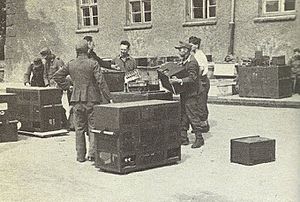TICOM facts for kids
TICOM (which stood for Target Intelligence Committee) was a top-secret project during World War II. It was created by the Allied forces to find and capture Germany's secret information. They were especially interested in anything about code-breaking and listening to enemy messages (called signals intelligence).
TICOM worked alongside other Allied efforts. These projects aimed to gather German science, technology, and even scientists after the war. Examples include Operation Paperclip (for rockets), Operation Alsos (for nuclear secrets), and Operation Surgeon (for aircraft technology). There was strong competition with the Soviet Union to get these same secrets. This race directly led to new missile technology. It also helped create the Cold War and even put a man on the Moon.
Contents
History of TICOM
The British first started the TICOM project. But when US Army Chief of Staff General George Marshall found out, it quickly became a joint British-American effort. The main goal was to find and capture Germany's secret code-breaking information.
The idea was to send teams of code-breaking experts into Germany. Most of these experts came from the famous Bletchley Park center. They would go with the front-line troops. Their mission was to grab documents, technology, and people from German intelligence groups. They had to do this before these valuable secrets could be destroyed, stolen, or taken by the Soviets. There were six special teams:
- Team 1 worked to capture German Geheimschreiber (secret writer) machines. Messages from these machines were code-named Fish.
- Team 2 helped Team 1 move Field Marshal Kesselring's communications train to Britain. This was called the "Jellyfish Convoy."
- Team 3 looked into a German signals intelligence unit called "Pers Z S" that was still working.
- Team 4 explored southern Germany in more detail. Team 1 had quickly passed over these areas.
- Team 5 found a waterproof box with secret papers from the Cipher Department of the High Command of the Wehrmacht (OKW/Chi). It was at the bottom of Lake Schliersee. This team then searched the lake for more valuable items.
- Team 6 aimed to capture and use materials from the German Naval Intelligence Center. They also targeted the German SIGINT headquarters.
German High Command's Code Unit
The Allies first thought that the German Supreme Command's code unit, the Oberkommando der Wehrmacht Chiffrierabteilung (OKW/Chi), was like their own Bletchley Park. But they found this was not true. Even though it was the top code-breaking agency in the German military, it did not set overall rules. It also did not organize or direct the code work of different German services.
Instead, OKW/Chi focused on hiring the best code-breakers. Their job was to design Germany's own secure communication systems. They also helped the individual military branches. These branches included:
- The Army (Heer)
- Air Force (Luftwaffe)
- Navy (Kriegsmarine)
- Foreign Office
- Nazi Party
Two doctors from OKW/Chi, Huttenhain and Fricke, were asked to write about how they solved German code machines. They wrote about machines like the Enigma (both with and without a plugboard), Hagelin machines, and various cipher teleprinters like the Siemens and Halske T52 and Lorenz SZ 40.
They believed that how the machines worked would be known. So, they only talked about solving the daily keys, not how to break the machines themselves. This showed that code-breakers knew the Enigma without a plugboard could be solved. Enigmas with the plugboard (Steckerbrett) were thought to be safe if used correctly. However, they were less secure if people used common starting phrases. They were also less secure during a time when a "faulty indicator technique" was used, up until May 1940. Still, the German experts believed the plugboard Enigma had never been fully solved.
Secret Nazi Party Office Found
In May 1945, TICOM made a surprising discovery. They found the Nazi Party's top-secret FA signals intelligence and code-breaking agency. It was located at the Kaufbeuren Air Base in southern Bavaria. This office was under the control of Luftwaffe chief Hermann Göring. It has been called "the richest, most secret, the most Nazi, and the most influential" of all German code intelligence groups.
Finding the "Russian Fish"
TICOM's biggest success was capturing the "Russian Fish." This was a set of German radio receivers. They were used to listen in on high-level Soviet radio teletype signals. On May 21, 1945, a TICOM team got a tip. A German POW knew about equipment and documents related to Russian messages.
After finding the rest of the German unit members, they were all taken back to their old base. The prisoners helped recover about 7.5 tons of equipment. One of the machines was put back together and shown to work. TICOM officer 1st Lt. Paul Whitaker later reported, "They were intercepting Russian traffic right while we were there…pretty soon they had shown us all we needed to see."
Other Related Efforts
In Operation Stella Polaris, the Finnish signals intelligence unit was moved to Sweden. This happened after Finland and the Soviet Union agreed to a cease-fire in September 1944. The records, including secret code materials, eventually ended up with the Americans.
See also
 In Spanish: TICOM para niños
In Spanish: TICOM para niños


